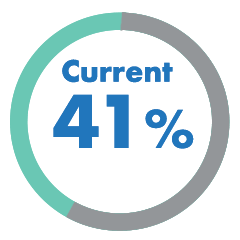Retirement may seem like a distant dream, but it’s never too early or too late to start planning. The “golden rule” suggests saving at least 15% of your pre-tax income, but with each individual’s financial situation being unique, how can you be sure you’re on the right track?
This comprehensive guide on “how much to save for retirement” will provide insights, strategies, and tools to help you confidently navigate your journey to retirement, regardless of your age or current savings. Let’s embark on the path to a secure and comfortable retirement starting today.
Key Takeaways
- Understanding and taking into account longevity, healthcare expenses, and price inflation is essential for retirement savings.
- Maximize retirement savings by contributing to employer plans and tax-advantaged accounts, investing in a diversified portfolio, and exploring other options.
- Utilize catch-up contributions when aged 50+, and use online calculators or financial planning apps/software to reach goals securely.
Determining Your Retirement Savings Goal

The general rule of thumb is to save at least 15% of your pre-tax income for retirement. However, it’s essential to consider individual factors such as your age, income and desired retirement lifestyle. Benchmarks for retirement savings become more complex for those nearing retirement, and they rely on income, marital status, and employer-sponsored retirement plans.
Employer contributions and investment returns play a significant role in achieving retirement savings goals. They can supplement your individual savings and facilitate growth over time. Tax-advantaged retirement accounts, such as traditional and Roth accounts, also offer valuable benefits to help you maximize your retirement savings.
Factors Influencing Retirement Savings
When planning for retirement, it’s crucial to consider factors that can influence your savings objectives. Longevity, healthcare expenses, and price inflation can significantly impact the amount you need to save for a comfortable retirement. Inflation, in particular, can necessitate a higher amount of money for retirement, affecting your pre-retirement income.
To stay ahead of inflation and safeguard your nest egg, it’s essential to educate yourself on strategies for managing your after-tax dollars for retirement savings. By understanding these factors and adjusting your savings plan accordingly, you’ll be better prepared for the financial demands of retirement.
Mondays 7:00 pm ET
Webinar: New Rules of Retirement Income Planning
Retirement has changed. Are you prepared? Learn how to build lasting and reliable income.
Reserve My Spot
Retirement Income Sources
When determining your retirement savings goal, it’s vital to consider various sources of retirement income. Some sources to consider include:
Social Security serves as the foundation of retirement savings for most Americans, providing social security benefits that supplement their income. The average monthly benefit for retired workers from Social Security is $1,833.
By factoring in multiple income sources, including your annual income, household income, and preretirement income, and understanding their potential impact on your retirement savings, you can create a more comprehensive and accurate plan for your financial future.
Saving Strategies by Age Group

Each decade of your life presents unique opportunities and challenges when it comes to retirement savings. Whether you’re just starting out in your 20s or playing catch-up in your 50s, understanding the strategies best suited for your age group can help you maximize your retirement savings and ensure you’re on track to meet your goals as you approach retirement age.
Developing a retirement savings plan that works for you is essential. Consider your current financial situation.
Starting Early: Saving in Your 20s
Beginning your retirement savings journey early has substantial benefits. Money saved in your 20s has a longer period to accrue and compound before being utilized during retirement. By the time you reach 30, it’s recommended to have retirement savings equal to your current annual salary. Even investing small amounts during your 20s can lead to greater savings over time.
In addition to starting early, establishing an emergency fund is crucial. The majority of this fund should remain in a more liquid account, ensuring it’s easily accessible when needed. By focusing on a strong foundation for retirement savings and taking advantage of employer-sponsored retirement plans or IRAs, you can set yourself up for long-term financial success.
Building Momentum: Saving in Your 30s
In your 30s, it’s essential to prioritize increasing your retirement savings. This may include augmenting contributions to retirement accounts, capitalizing on employer contributions and tax-advantaged accounts, and investing in a diversified portfolio. To maintain financial security, ensure you have at least six months of living expenses in emergency savings.
Additionally, here are some options to consider for optimizing your retirement savings.
- Explore options for investing additional funds in a brokerage account
- Open an educational savings account for your child’s future
- Ensure you’re receiving your full employer match regarding your contribution percentage
By taking advantage of these opportunities, you can maximize your retirement savings.
Accelerating Savings: Saving in Your 40s
Your 40s is the time to prioritize maximizing your retirement savings. Focus on debt reduction, maintaining an emergency fund, and aiming for six times your current annual salary in retirement savings by age 50. Some advantageous strategies for saving money during this decade include paying off all debt, investing independently via IRAs, maintaining a proper investment mix, constructing an emergency fund, setting aside money for retirement, and investing in non-retirement accounts.
Establishing an estate plan and will is also crucial during this time. Strive to save 30% or more of your income and focus on your retirement savings rate, while thoroughly analyzing your portfolio to ensure you’re on track for a comfortable retirement.
Catching Up: Saving in Your 50s
If you’re in your 50s and behind on your retirement savings, it’s not too late to catch up. Here are some steps you can take.
- Focus on paying off debt.
- Adjust your investment strategies to potentially earn higher returns.
- Maximize your retirement contributions.
- Review your contribution percentage annually to ensure you’re progressing towards your retirement savings goals.
Consider increasing your retirement contributions, looking for seasonal employment during the holiday period, or finding other ways to supplement your retirement savings. By taking action now, you can still make significant progress towards your retirement goals and achieve financial security in your golden years. And if you can’t make the goals, don’t worry; there are plenty of benefits of retiring in your 70s too.
The Role of Employer Contributions and Investment Returns

Employer contributions and investment returns play a crucial role in retirement savings, helping to grow your nest egg over time. By understanding the significance of employer contributions, such as matching programs, and the impact of investment returns on your retirement savings, you can make informed decisions and maximize your savings potential.
Employer contributions can be a great way to boost your retirement savings. Many employers offer matching.
Maximizing Employer Contributions
Employer contributions are funds that employers provide to their employees’ retirement accounts, typically in the form of matching funds or fixed contributions. To make the most of employer matching programs, contribute as much as possible to your retirement account, up to the maximum amount your employer will match.
To increase your contributions, consider raising the amount you contribute each month or the percentage of your salary you contribute. Consistently reviewing the app’s features, updating the app when necessary, and ensuring you’re taking full advantage of employer contributions can help you optimize your retirement savings.
Understanding Investment Returns
Investment returns can impact your retirement savings by diminishing the amount of principal that must be withdrawn each year, enabling the potential to expand the account over time. Factors such as risk tolerance, diversification, and time horizon can influence investment returns.
To evaluate investment returns, consider the rate of return, the volatility of the returns, and the risk-adjusted return. Understanding the returns allows you to analyze the profitability and risk associated with different investment options, helping you make informed decisions based on your risk tolerance and financial objectives.
Tax-Advantaged Retirement Accounts

Tax-advantaged retirement accounts, such as traditional and Roth IRAs or 401(k)s, can help maximize your retirement savings by providing tax benefits. These accounts enable you to deposit pre-tax or after-tax money, and the earnings on the investments accrue tax-free or are taxed at a reduced rate.
Contributing to a tax-advantaged retirement account can be a great way to save for retirement and accumulate retirement money.
Comparing Traditional and Roth Accounts
Traditional and Roth accounts are two types of retirement accounts with fundamental differences in the manner in which they are taxed. Traditional accounts are funded with pre-tax dollars, and withdrawals are subject to income tax, while Roth accounts are funded with post-tax dollars, and qualified withdrawals are exempt from taxation.
Choosing between traditional and Roth accounts, such as a Roth IRA, depends on your tax rate and retirement goals. Considering factors like tax rates and withdrawal rules can help you determine which type of account best suits your financial situation and retirement goals.
Contribution Limits and Catch-Up Contributions
For 2022, the contribution limit for both traditional and Roth accounts is $6,000. However, those aged 50 or over by the end of the year can contribute an additional $1,000, making the total contribution limit $7,000.
Catch-up contributions are additional contributions that those aged 50 and older are eligible to make to their retirement accounts. By being aware of annual contribution limits and taking advantage of catch-up contributions, you can ensure you’re maximizing your retirement savings potential.
Retirement Savings Calculators and Tools

Utilizing retirement savings calculators and tools can help you estimate future savings, identify gaps in your plan, and adjust your strategies accordingly. By gaining insights from these resources, you can make informed decisions and ensure you’re on the right track toward a comfortable retirement.
Retirement calculators can provide you with a snapshot of your current financial situation and help you plan for retirement.
Online Retirement Calculators
Online retirement calculators can help you estimate your savings goals and track your progress. These calculators offer:
- Precision
- Convenience
- Personalization
- Visualization
They allow you to input various factors to tailor the estimates to your specific financial circumstances.
By using an online retirement calculator, you can:
- Create a retirement savings plan
- Set realistic goals
- Determine how much needs to be saved each month to achieve your desired retirement income
- Identify areas that may require adjustments in spending or investment strategy
These tools can help you plan for a secure retirement.
Financial Planning Apps and Software

Financial planning apps and software provide digital resources to assist you in managing your finances, budget, and investments. They offer user-friendly interfaces, allowing you to easily monitor and organize your finances, set objectives, and make informed decisions concerning your funds.
However, it’s important to be cautious of data breaches and security risks when using financial planning apps and software. To mitigate these risks, ensure the app is secure, all data is encrypted, and thoroughly read the terms and conditions before signing up. Consistently review the app’s features and update the app when necessary to protect your financial information and maximize its benefits.
Institute of Financial Wellness
The Institute of Financial Wellness offers resources, education, and guidance to help individuals achieve their retirement savings goals and maintain financial well-being throughout their lives. With tools like the retirement savings calculator, you can project your retirement savings and identify potential gaps.
By taking advantage of the Institute’s offerings, you can ensure you’re on track to meet your retirement objectives and enjoy a financially secure future.
See How You Can Boost Your IFW Retirement Score

When you request your IFW Retirement Score, an IFW Certified Financial Professional will help you discover ways to:

Lower or potentially eliminate taxes in retirement

Protect your retirement portfolio

Secure a stable income stream throughout retirement
Full Summary
The golden rule of saving 15% of your pre-tax income for retirement serves as a starting point, but individual circumstances and factors must also be considered. By understanding the various strategies, tools, and resources available, you can confidently plan for a comfortable retirement, regardless of your age or current savings. Remember, it’s never too early or too late to start planning for your future financial security.
Frequently Asked Questions
Can I retire at 60 with 500k?
Retiring at 60 with $500,000 is possible if you downsize, adopt a minimalist lifestyle, and have a pension plan, annuity, or Social Security benefits to supplement your savings.
With a 4% withdrawal rate from the assets, you should be able to withdraw $20,000 per year for your retirement, while an annuity can provide you a guaranteed income of up to $30,500 each year.
How much should I save for retirement by age?
By age 30, you should have the equivalent of your annual salary saved; by age 40, three times your income; by age 50, six times your income; by age 60, eight times your income; and by age 67, 10 times your income.
Can you retire with $1.5 million comfortably?
Yes, you can retire comfortably with $1.5 million. According to the 4% rule, it should provide approximately $60,000 a year before taxes for your retirement needs.
This amount can be further supplemented by an annuity that will provide a guaranteed income of $91,500 annually starting immediately.
Can I retire at 50 with 300k?
Retiring at 50 with $300,000 may be possible if you have other resources like a pension, rental income, or other investments; however, typically, you need Social Security to ensure a stable retirement, and for most people, that won’t start until their 60s.
Retirement planning is a complex process and requires careful consideration of all your resources. It’s important to understand the different sources of income you have available and how they can be used to create a secure retirement. Social Security is an important part of this equation and should be taken into account when planning for retirement.
Is 20% into retirement too much?
20% into retirement may be too much since experts recommend between 10-15%. While overfunding your 401(k) or IRA is not necessarily bad, it can cause sacrifices that you might have to make during your working years.
For example, if you are putting too much money into your retirement accounts, you may not be able to save for other goals, such as a house or a car.




